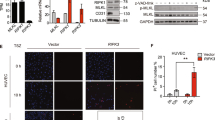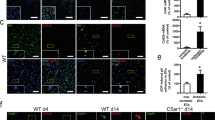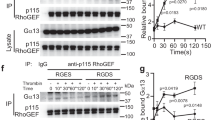Abstract
Selectins mediate leukocyte rolling and prime leukocytes for integrin-mediated leukocyte adhesion. However, neither the in vivo importance of nor the signaling pathway by which selectin-mediated integrin activation occurs has been determined. We report here that P-selectin-deficient mice manifested impaired leukocyte adhesion, which was 'rescued' by soluble P-selectin. Mechanistically, the cytoplasmic domain of P-selectin glycoprotein ligand 1 formed a constitutive complex with Nef-associated factor 1. After binding of P-selectin, Src kinases phosphorylated Nef-associated factor 1, which recruited the phosphoinositide-3-OH kinase p85-p110δ heterodimer and resulted in activation of leukocyte integrins. Inhibition of this signal-transduction pathway diminished the adhesion of leukocytes to capillary venules and suppressed peritoneal infiltration of leukocytes. Our data demonstrate the functional importance of this newly identified signaling pathway mediated by P-selectin glycoprotein ligand 1.
This is a preview of subscription content, access via your institution
Access options
Subscribe to this journal
Receive 12 print issues and online access
$209.00 per year
only $17.42 per issue
Buy this article
- Purchase on Springer Link
- Instant access to full article PDF
Prices may be subject to local taxes which are calculated during checkout






Similar content being viewed by others
Change history
13 November 2013
In the version of this article initially published, in Figure 4b the row labeled 'IB: α-PSGL-1 monomer' is incorrect; it is a duplicate of the row above. The error has been corrected in the HTML and PDF versions of the article.
References
Springer, T.A. Traffic signals for lymphocyte recirculation and leukocyte emigration: the multistep paradigm. Cell 76, 301–314 (1994).
Furie, B. & Furie, B.C. The molecular basis of platelet and endothelial cell interaction with neutrophils and monocytes: role of P-selectin and the P-selectin ligand, PSGL-1. Thromb. Haemost. 74, 224–227 (1995).
Hynes, R.O. Integrins: bidirectional, allosteric signaling machines. Cell 110, 673–687 (2002).
Laudanna, C., Kim, J.Y., Constantin, G. & Butcher, E. Rapid leukocyte integrin activation by chemokines. Immunol. Rev. 186, 37–46 (2002).
McEver, R.P. Selectins: lectins that initiate cell adhesion under flow. Curr. Opin. Cell Biol. 14, 581–586 (2002).
Wagner, D.D. New links between inflammation and thrombosis. Arterioscler. Thromb. Vasc. Biol. 25, 1321–1324 (2005).
Mayadas, T.N., Johnson, R.C., Rayburn, H., Hynes, R.O. & Wagner, D.D. Leukocyte rolling and extravasation are severely compromised in P selectin-deficient mice. Cell 74, 541–554 (1993).
Yang, J. et al. Targeted gene disruption demonstrates that P-selectin glycoprotein ligand 1 (PSGL-1) is required for P-selectin-mediated but not E-selectin-mediated neutrophil rolling and migration. J. Exp. Med. 190, 1769–1782 (1999).
Plow, E.F., Haas, T.A., Zhang, L., Loftus, J. & Smith, J.W. Ligand binding to integrins. J. Biol. Chem. 275, 21785–21788 (2000).
Bunting, M., Harris, E.S., McIntyre, T.M., Prescott, S.M. & Zimmerman, G.A. Leukocyte adhesion deficiency syndromes: adhesion and tethering defects involving β2 integrins and selectin ligands. Curr. Opin. Hematol. 9, 30–35 (2002).
Kim, M., Carman, C.V., Yang, W., Salas, A. & Springer, T.A. The primacy of affinity over clustering in regulation of adhesiveness of the integrin αLβ2 . J. Cell Biol. 167, 1241–1253 (2004).
Reedquist, K.A., Ludikhuize, J. & Tak, P.P. Phosphoinositide 3-kinase signaling and FoxO transcription factors in rheumatoid arthritis. Biochem. Soc. Trans. 34, 727–730 (2006).
Okkenhaug, K. & Vanhaesebroeck, B. PI3K in lymphocyte development, differentiation and activation. Nat. Rev. Immunol. 3, 317–330 (2003).
Ma, Y-Q., Plow, E.F. & Geng, J.-G. P-selectin binding to P-selectin glycoprotein ligand-1 induces an intermediate state of αMβ2 activation and acts cooperatively with extracellular stimuli to support maximal adhesion of human neutrophils. Blood 104, 2549–2556 (2004).
Atarashi, K., Hirata, T., Matsumoto, M., Kanemitsu, N. & Miyasaka, M. Rolling of Th1 cells via P-selectin glycoprotein ligand-1 stimulates LFA-1-mediated cell binding to ICAM-1. J. Immunol. 174, 1424–1432 (2005).
Woollard, K.J. et al. Raised plasma soluble P-selectin in peripheral arterial occlusive disease enhances leukocyte adhesion. Circ. Res. 98, 149–156 (2006).
Blanks, J.E., Moll, T., Eytner, R. & Vestweber, D. Stimulation of P-selectin glycoprotein ligand-1 on mouse neutrophils activates β2-integrin mediated cell attachment to ICAM-1. Eur. J. Immunol. 28, 433–443 (1998).
Evangelista, V. et al. Platelet/polymorphonuclear leukocyte interaction in dynamic conditions: evidence of adhesion cascade and cross talk between P-selectin and the β2 integrin CD11b/CD18. Blood 88, 4183–4194 (1996).
Evangelista, V. et al. Platelet/polymorphonuclear leukocyte interaction: P-selectin triggers protein-tyrosine phosphorylation-dependent CD11b/CD18 adhesion: role of PSGL-1 as a signaling molecule. Blood 93, 876–885 (1999).
Dunne, J.L., Ballantyne, C.M., Beaudet, A.L. & Ley, K. Control of leukocyte rolling velocity in TNF-α-induced inflammation by LFA-1 and Mac-1. Blood 99, 336–341 (2002).
Dunne, J.L., Collins, R.G., Beaudet, A.L., Ballantyne, C.M. & Ley, K. Mac-1, but not LFA-1, uses intercellular adhesion molecule-1 to mediate slow leukocyte rolling in TNF-α-induced inflammation. J. Immunol. 171, 6105–6111 (2003).
Fukushi, M. et al. Identification and cloning of a novel cellular protein Naf1, Nef-associated factor 1, that increases cell surface CD4 expression. FEBS Lett. 442, 83–88 (1999).
Beyaert, R., Heyninck, K. & Huffel, S.V. A20 and A20-binding proteins as cellular inhibitors of nuclear factor-κB-dependent gene expression and apoptosis. Biochem. Pharmacol. 60, 1143–1151 (2000).
Gupta, K., Ott, D., Hope, T.J., Siliciano, R.F. & Boeke, J.D. A human nuclear shuttling protein that interacts with human immunodeficiency virus type 1 matrix is packaged into virions. J. Virol. 74, 11811–11824 (2000).
Geng, J.-G. et al. Expression of a P-selectin ligand in zona pellucida of porcine oocytes and P-selectin on acrosomal membrane of porcine sperm cells. Potential implications for their involvement in sperm-egg interactions. J. Cell Biol. 137, 743–754 (1997).
Serrador, J.M. et al. A juxta-membrane amino acid sequence of P-selectin glycoprotein ligand-1 is involved in moesin binding and ezrin/radixin/moesin-directed targeting at the trailing edge of migrating lymphocytes. Eur. J. Immunol. 32, 1560–1566 (2002).
Hu, Y. et al. Requirement of Src kinases Lyn, Hck and Fgr for BCR-ABL1-induced B-lymphoblastic leukemia but not chronic myeloid leukemia. Nat. Genet. 36, 453–461 (2004).
Fittipaldi, A. & Giacca, M. Transcellular protein transduction using the Tat protein of HIV-1. Adv. Drug Deliv. Rev. 57, 597–608 (2005).
Forsyth, K.D. & Levinsky, R.J. Preparative procedures of cooling and re-warming increase leukocyte integrin expression and function on neutrophils. J. Immunol. Methods 128, 159–163 (1990).
Glasser, L. & Fiederlein, R.L. The effect of various cell separation procedures on assays of neutrophil function. A critical appraisal. Am. J. Clin. Pathol. 93, 662–669 (1990).
Kuijpers, T.W. et al. Membrane surface antigen expression on neutrophils: a reappraisal of the use of surface markers for neutrophil activation. Blood 78, 1105–1111 (1991).
Simon, S.I., Hu, Y., Vestweber, D. & Smith, C.W. Neutrophil tethering on E-selectin activates β2 integrin binding to ICAM-1 through a mitogen-activated protein kinase signal transduction pathway. J. Immunol. 164, 4348–4358 (2000).
Weber, C. & Springer, T.A. Neutrophil accumulation on activated, surface-adherent platelets in flow is mediated by interaction of Mac-1 with fibrinogen bound to αIIbβ3 and stimulated by platelet-activating factor. J. Clin. Invest. 100, 2085–2093 (1997).
Cully, M., You, H., Levine, A.J. & Mak, T.W. Beyond PTEN mutation: the PI3K pathway as an integrator of multiple inputs during tumorigenesis. Nat. Rev. Cancer 6, 184–192 (2006).
Okkenhaug, K. et al. Impaired B and T cell antigen receptor signaling in p110δ PI 3-kinase mutant mice. Science 297, 1031–1034 (2002).
Nolte, D. et al. Leukocyte rolling in venules of striated muscle and skin is mediated by P-selectin, not by L-selectin. Am. J. Physiol. 267, H1637–H1642 (1994).
Weninger, W. et al. Specialized contributions by α(1,3)-fucosyltransferase-IV and FucT-VII during leukocyte rolling in dermal microvessels. Immunity 12, 665–676 (2000).
Chen, M. & Geng, J-G. P-selectin mediates adhesion of leukocytes, platelets, and cancer cells in inflammation, thrombosis, and cancer growth and metastasis. Arch. Immunol. Ther. Exp. 54, 75–84 (2006).
Ushiyama, S., Laue, T.M., Moore, K.L., Erickson, H.P. & McEver, R.P. Structural and functional characterization of monomeric soluble P-selectin and comparison with membrane P-selectin. J. Biol. Chem. 268, 15229–15237 (1993).
Barkalow, F.J., Barkalow, K.L. & Mayadas, T.N. Dimerization of P-selectin in platelets and endothelial cells. Blood 96, 3070–3077 (2000).
Nandi, A., Estess, P. & Siegelman, M. Bimolecular complex between rolling and firm adhesion receptors required for cell arrest: CD44 association with VLA-4 in T cell extravasation. Immunity 20, 455–465 (2004).
Korade-Mirnics, Z. & Corey, S.J. Src kinase-mediated signaling in leukocytes. J. Leukoc. Biol. 68, 603–613 (2000).
Piccardoni, P. et al. Platelet/polymorphonuclear leukocyte adhesion: a new role for SRC kinases in Mac-1 adhesive function triggered by P-selectin. Blood 98, 108–116 (2001).
Totani, L. et al. Src-family kinases mediate an outside-in signal necessary for β2 integrins to achieve full activation and sustain firm adhesion of polymorphonuclear leucocytes tethered on E-selectin. Biochem. J. 396, 89–98 (2006).
Giagulli, C. et al. The Src family kinases Hck and Fgr are dispensable for inside-out, chemoattractant-induced signaling regulating β2 integrin affinity and valency in neutrophils, but are required for β2 integrin-mediated outside-in signaling involved in sustained adhesion. J. Immunol. 177, 604–611 (2006).
Bullard, D.C. et al. P-selectin/ICAM-1 double mutant mice: acute emigration of neutrophils into the peritoneum is completely absent but is normal into pulmonary alveoli. J. Clin. Invest. 95, 1782–1788 (1995).
Ma, L., Raycroft, L., Asa, D., Anderson, D.C. & Geng, J-G. A sialoglycoprotein from human leukocytes functions as a ligand for P-selectin. J. Biol. Chem. 269, 27739–27746 (1994).
Croce, K., Freedman, S.J., Furie, B.C. & Furie, B. Interaction between soluble P-selectin and soluble P-selectin glycoprotein ligand 1: equilibrium binding analysis. Biochemistry 37, 16472–16480 (1998).
Geng, J.-G. et al. Rapid neutrophil adhesion to activated endothelium mediated by GMP-140. Nature 343, 757–760 (1990).
Boxio, R., Bossenmeyer-Pourie, C., Steinckwich, N., Dournon, C. & Nusse, O. Mouse bone marrow contains large numbers of functionally competent neutrophils. J. Leukoc. Biol. 75, 604–611 (2004).
Acknowledgements
We thank B. Vanhaesebroeck (Ludwig Institute for Cancer Research) for p110δ-mutant mice; J. Downward (Imperial Cancer Research Fund) for the plasmid encoding p85; and L. Li (Shanghai Institutes for Biological Sciences) for the plasmid encoding PTEN. Supported by the National Science Foundation of China (30370694, 30421005, 30623003, 30400245 and 30630036), the Ministry of Science and Technology of China (2002CB513006, 2006CB943902 and 2006AA02Z169), the Chinese Academy of Sciences (KSCX2-YW-R-67 and KJCX2-YW-H08), the Shanghai Municipal Commission for Science and Technology (04JC14078, 06DZ22032, 55407035 and 058014578) and the National Institutes of Health (RO1AI064743 and P50HL081011).
Author information
Authors and Affiliations
Contributions
H.-B.W., J.-T.W., L.Z., Z.H.G., W.-L.X. and T.X. did the research and analyzed the data; Y.H., X.Z., E.F.P., M.C. and J.-G.G. designed the research; and J.-G.G. wrote the manuscript.
Corresponding authors
Ethics declarations
Competing interests
The authors have applied for a patent in China based on this work (application 200710041403.0).
Supplementary information
Supplementary Text and Figures
Supplementary Figures 1–12 and Supplementary Methods (PDF 1632 kb)
Rights and permissions
About this article
Cite this article
Wang, HB., Wang, JT., Zhang, L. et al. P-selectin primes leukocyte integrin activation during inflammation. Nat Immunol 8, 882–892 (2007). https://doi.org/10.1038/ni1491
Received:
Accepted:
Published:
Issue Date:
DOI: https://doi.org/10.1038/ni1491
This article is cited by
-
The roles of P-selectin in cancer cachexia
Medical Oncology (2023)
-
Nets, pulmonary arterial hypertension, and thrombo-inflammation
Journal of Molecular Medicine (2022)
-
Histone H4 aggravates inflammatory injury through TLR4 in chlorine gas-induced acute respiratory distress syndrome
Journal of Occupational Medicine and Toxicology (2020)
-
Crosstalk between reactive oxygen species and pro-inflammatory markers in developing various chronic diseases: a review
Applied Biological Chemistry (2017)
-
Pulmonary endothelial activation caused by extracellular histones contributes to neutrophil activation in acute respiratory distress syndrome
Respiratory Research (2016)



